
SHINKO ELECTRIC INDUSTRIES CO., LTD.

SHINKO ELECTRIC INDUSTRIES CO., LTD.
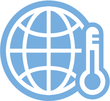 Climate Change
Climate Change
The Shinko Group is engaged in a variety of activities to fulfill the responsibility of a manufacturing company to reduce environmental impact. Among these, the greatest priority is given to responding to climate change, and related activities are conducted throughout the company.
International frameworks such as the Paris Agreement, together with the strengthening of global regulations and expanded application of carbon taxes, are accelerating the trend toward decarbonization in many countries throughout the world. The Shinko Group is working to respond to climate change by clarifying its goals in accordance with its Environmental Policy and Environmental Vision 2050 and by setting medium- to long-term environmental targets. We are strengthening our activities to achieve carbon neutrality as soon as possible and contribute to the realization of a decarbonized society.

The Financial Stability Board (FSB) has established the Task Force on Climate-related Financial Disclosures (TCFD) to reduce the risk of instability related to climate change in financial markets. Responding to the TCFD recommendations in 2017, the Shinko Group has committed to making disclosures in line with the recommendations, and as SHINKO ELECTRIC INDUSTRIES CO., LTD., we expressed our support for the TCFD recommendations in May 2022.
The Shinko Group actively discloses information on climate change to investors and other stakeholders.
We have established the Environmental Committee chaired by the Representative Director of Board, President, and the Environmental Measures Execution Committee as a subordinate organization under the Committee, as a framework for promoting environmental management. They deliberate on environmental issues, including Environmental Policy, specific environmental targets, and environmental management systems, etc. (assessments, monitoring, and management of business risks and opportunities due to climate change), while sharing and managing the progress on activities addressing climate change and other environmental issues.
Furthermore, at each of our plants in Japan, we have established Green Factory Promotion Subcommittees consisting of manufacturing divisions and related divisions to implement specific climate change measures, including the promotion of energy conservation and the introduction of high-efficiency equipment in manufacturing processes and plant utility equipment. The results of these measures are reported regularly (twice a year) to the Board of Directors by the Environmental Committee, so that appropriate supervision by the Board of Directors is ensured.
Our overseas manufacturing subsidiaries are also working to reduce their environmental impact, including climate change, under their own sustainability promotion systems.
The Risk Management Committee, chaired by the Representative Director of Board, President, has been established as a company-wide risk management system, including responses to climate change risk, to promote risk management for the entire group. To fully understand and respond to risks that could impact our business operations, including climate change, we analyze and respond to risks Groupwide. The Board of Directors receives regular reports on the important risks that have been identified, analyzed, and evaluated.
In addition, our Group has established an environmental management system based on ISO 14001 certification, and the results of activities are reported to the Board of Directors.
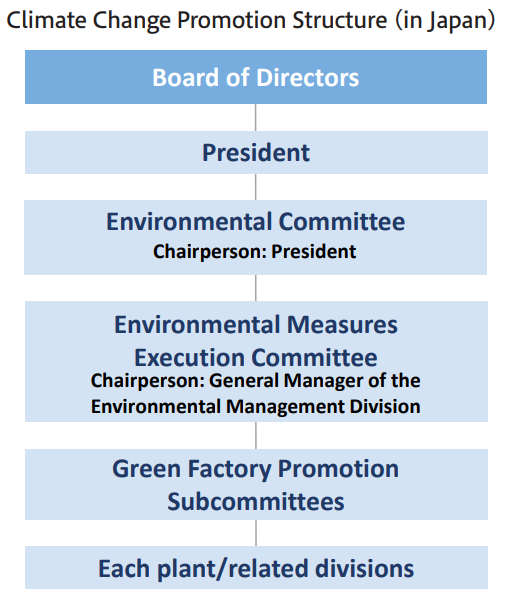
Evaluation of the Importance of Risks and Opportunities
To begin our scenario analysis, we identify the current and future climate change risks and opportunities facing our group and assess their importance based on the magnitude of their impact on our business.
Please refer to Sustainability Report 2024 (Climate Change Strategy, p. 34) for the Evaluation of the Importance.
Defining Scenario Groups
Based on the sixth assessment report released by the Intergovernmental Panel on Climate Change (IPCC), the Shinko Group has established a "2°C or lower scenario" and a "4°C scenario." We are using external information such as the International Energy Agency's (IEA) STEPS (Stated Policies Scenario), APS (Announced Pledges Scenario), and NZE (Net Zero Emissions by 2050 Scenario) as references up to the year 2050.
In the 2°C or lower scenario, we expect tighter regulations, such as the introduction of a carbon tax, and the risk of higher prices for electricity and raw materials like metal. We also expect opportunities in the form of increased sales of low-carbon, energy-saving products thanks to efficiency improvements in manufacturing facilities achieved by meeting the decarbonization needs of markets and customers, and stabilization of costs associated with the creation of renewable energy. In the 4°C scenario, physical risks are assumed to increase due to an increase in the frequency and scale of disasters such as windstorms and floods, resulting from the intensification of disasters caused by extreme weather events.
Business impact assessment
Based on the scenario analysis, the business impact assessment of transition risk in the 2°C or lower scenario is as follows.
In the below 2°C scenario, the financial impact of the introduction of a carbon price in 2050 is significant.
Based on these results, we will take measures to respond to future risks.
The 4°C scenario and other risks and opportunities will be evaluated in the future.
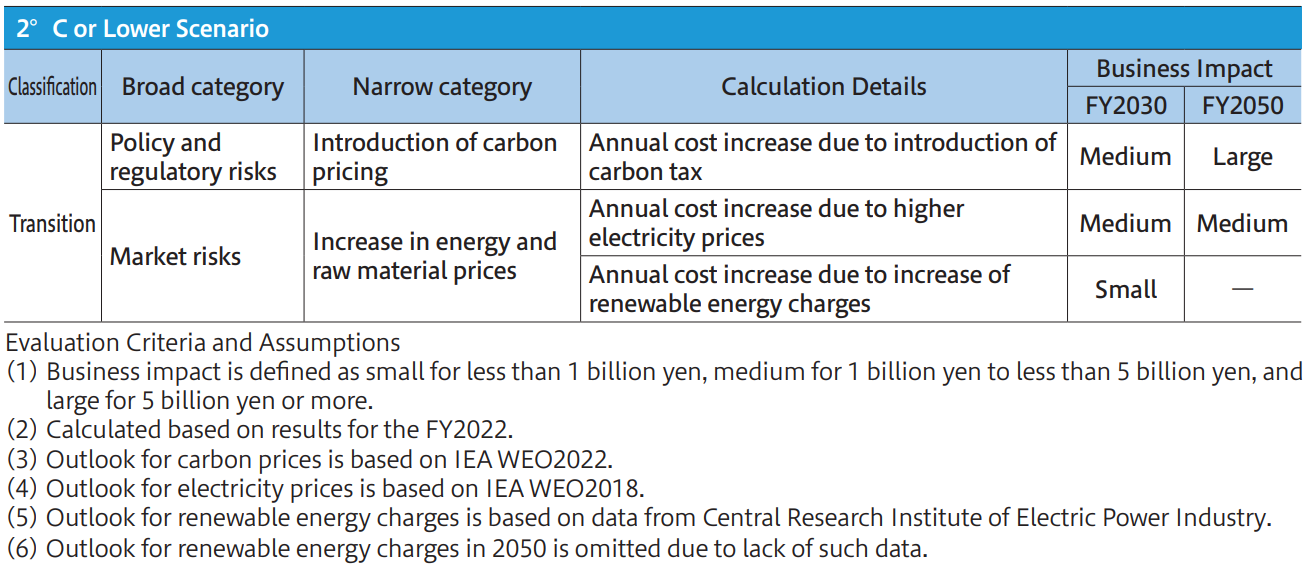
In order to respond to risks and realize opportunities based on these assessments and analyses, we are working to achieve carbon neutrality, which means virtually zero greenhouse gas emissions by 2050, in line with our medium- to long-term environmental targets established in 2021.
Risk Management Process
To fully understand and respond to risks that could affect the business operations of the Shinko Group, including climate change, we identify, assess, and manage risks across the Group. In order to conduct regular company-wide risk assessments, each division and group company conduct assessments on risk threats, such as the impact and likelihood of the occurrence of risks, and the status of countermeasures. For the risks related to climate change, we use information collected from across the Group to assess policies, reputation, natural disasters, the supply chain, products and services, etc. The results of the assessments, answered by each division, are conducted using a centralized matrix analysis to investigate the possible impact and likelihood of occurrence, then high-priority risks are identified at the company-wide level. The results of these analyses are reported to the Board of Directors.
In addition, the Environmental Committee shares business risks, opportunities, and countermeasures related to climate change and manages the progress of countermeasures. In addition, the Shinko Group has established an environmental management system based on ISO 14001. Under this system, we monitor risks on compliance, etc.
Adaptation to Climate Changes
As part of our efforts to adapt to climate change, we are strengthening our internal countermeasures to reflect the increasing severity and frequency of typhoons and floods caused by extreme weather events. Specifically, in addition to taking preliminary measures based on hazard maps and other information at each site, we are working to minimize damage by establishing a "Typhoon and Flood Damage Timeline" for each site and division that defines action criteria and outlines of actions to take in the event of a disaster, and by conducting training on an ongoing basis.
The Shinko Group, recognizing the importance of reducing greenhouse gas emissions and adopting renewable energy for countering climate-related risks, uses greenhouse gas emissions and renewable energy adoption rates as key metrics. With regard to the reduction of net greenhouse gas emissions, we aim to achieve carbon neutrality with net-zero emissions by FY2050. Backcasting from that, we have established a target for FY2030 and are conducting activities to help us meet it. In the area of renewable energy utilization, we have set a target of 100% utilization by FY2030 and are working toward that target. We have also set annual targets and are monitoring metrics to manage the progress of our strategy and associated risks.
Note: Boundary of the targets is Scope 1 and Scope 2 at all business sites in Japan.
Targets・Results

Net reduction rate of greenhouse gas emissions
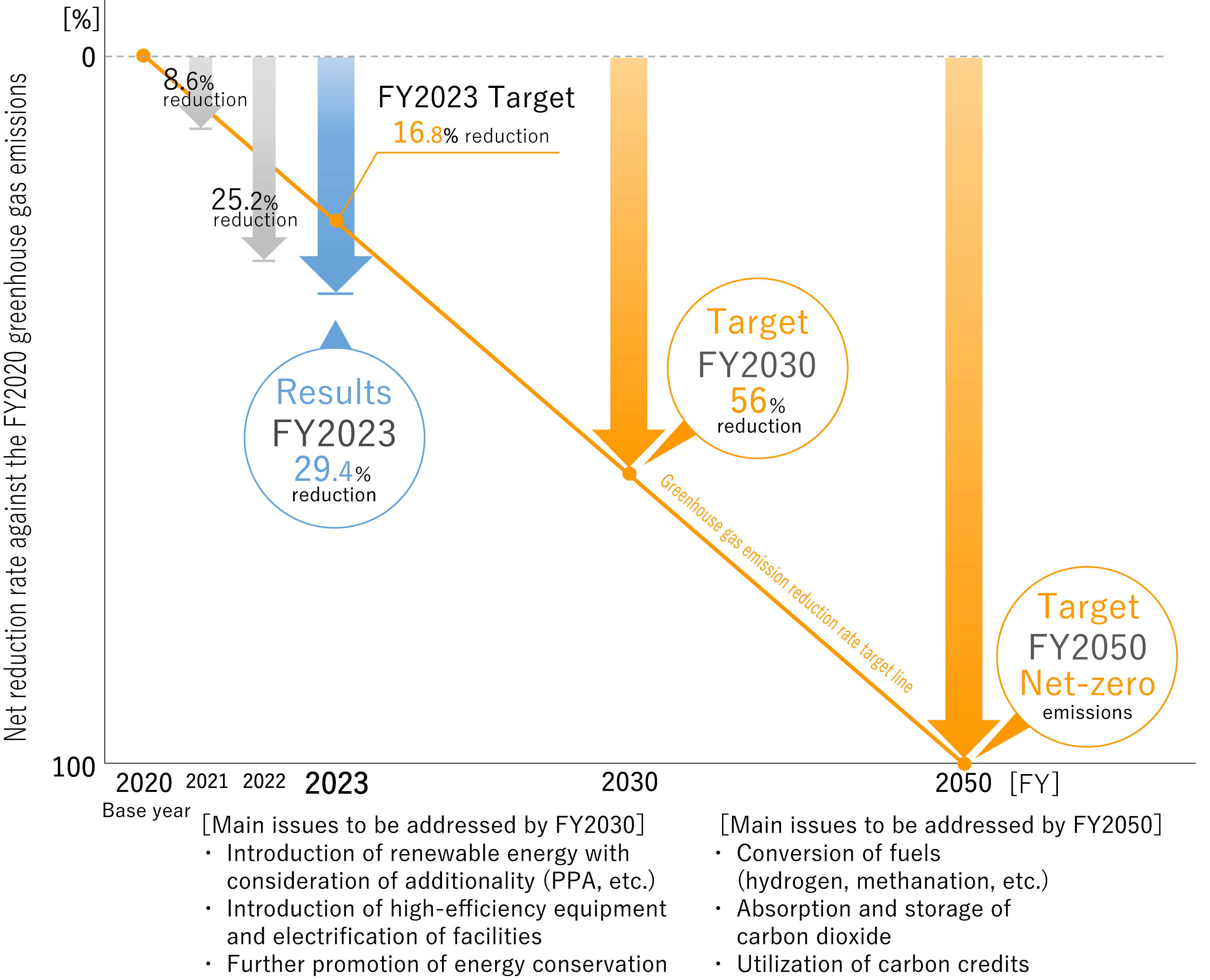
Rate or renewable energy use
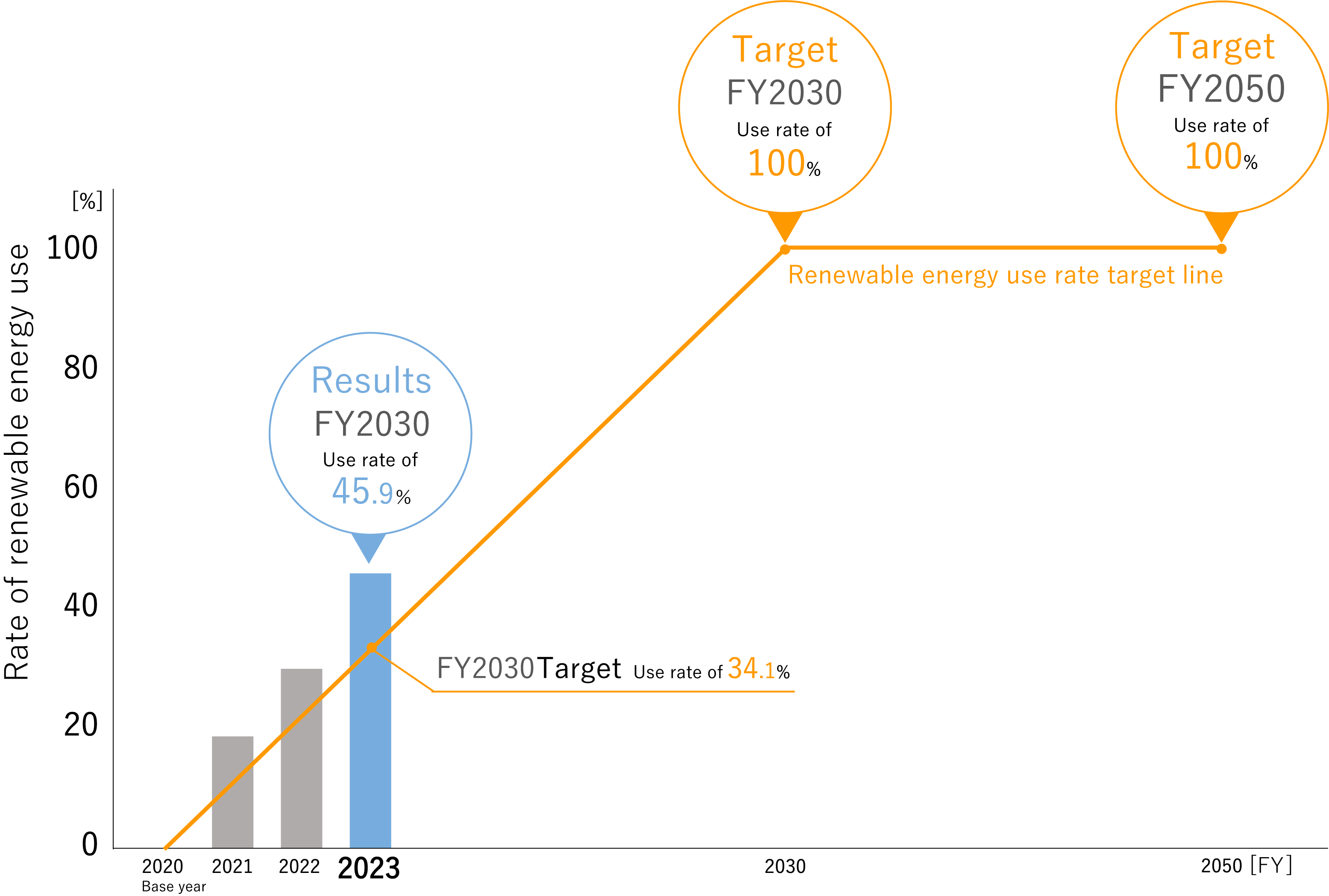
For details, please refer to Sustainability Report 2024 (Climate Change Metrics and Targets, p. 36).
At each plant, the Green Factory Promotion Subcommittee, in which all manufacturing divisions, facilities management divisions, and related divisions participate, is central to promoting the reduction of CO2 emissions through energy conservation and energy efficiency improvements in manufacturing and utility facilities.
By implementing various measures at plants in Japan, including consolidation of equipment, reduction of standby power, and the switch to LED lighting, we are strengthening company-wide efforts to realize low carbon manufacturing processes and facilities through efficient energy use.
In addition, we have introduced the concept of internal carbon pricing (ICP)*, which converts CO2 emissions from capital investments into monetary amounts and uses them as a basis for making investment decisions, and we are using it to reduce CO2 emissions.
Although energy consumption is expected to increase in the future due to the construction of a new plant and buildings and the expansion of production facilities in line with the strengthening of the production system, we will further strengthen various measures to reduce CO2 emissions.
* Internal Carbon Pricing (ICP): A mechanism whereby companies set their own price for CO2 emissions and use it to make investment decisions
Examples of Activities
At the Takaoka Plant (Nakano City, Nagano Prefecture) and Arai Plant (Myoko City, Niigata Prefecture), hot exhaust air of several hundred degrees Celsius was constantly generated in the electric furnace process. In an effort to reduce energy loss, a system was adopted to return a portion of this exhaust back into the electric furnace and reuse it for heating.
This system significantly reduced the amount of electricity required for heating, leading to a reduction in CO2 emissions and costs.
Effects of using waste heat from the electric furnace (FY2023)
・Power savings: 218 MWh
・CO2 reduction: 92 t-CO2
・Cost reduction: 5.7 million yen
CO2 from electricity purchased from external sources accounts for a large proportion of the CO2 emitted in the course of the Shinko Group's business activities. We have been installing photovoltaic power generation equipment at our business sites to expand the use of renewable energy.
In FY2023, we installed a photovoltaic power generation system on the roof of the Chikuma Plant (Chikuma City, Nagano Prefecture), which was newly established in December 2023, and are using the power generated for part of the electricity used at the plant.
In addition, through the purchase of CO2-free electricity from electric power companies and the use of non-fossil certificates, we were able to procure approximately 149 GWh of renewable energy, resulting in a use rate of approximately 45.9%, which significantly exceeded our target. At the same time, CO2 emissions were reduced by approximately 69,000 t-CO2.
Aiming to achieve a 100% renewable energy use rate, we will continue to focus on the creation and introduction of renewable energy by expanding the installation of solar power generation facilities at existing plants and newly constructed plants/buildings, as well as by purchasing CO2-free electricity and expanding the use of non-fossil certificates.
We will continue to contribute to the achievement of carbon neutrality and the realization of a decarbonized society by strengthening and accelerating various company-wide initiatives.